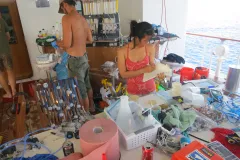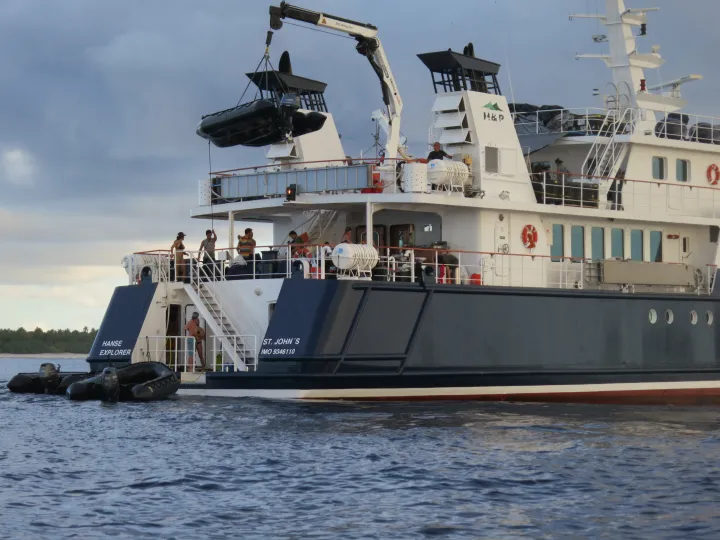Sequencing at Sea: Studying Small Things Using Big Equipment

Microbes are some of the most important organisms in the sea. These miniscule organisms provide an important link in the food web between the dissolved nutrients in the ocean and larger organisms like corals, fishes, and sharks. Without the microbes nothing would be able to use those nutrients, and the machinery of the ocean’s food web would grind to a halt.
While microbes are very easy to collect—just scoop up a handful of seawater—they are not very easy to study because they are so small. So a bit counterintuitively, when we study the smallest members of the marine community, we need big pieces of equipment to see what they do. We need microscopes to observe them up close, and heavy machines to extract and analyze the DNA from the tiny cells. All this big machinery makes studying microbes on a research ship especially complicated because there isn’t much room to spare and what there is sways with the ocean’s waves!
On a Southern Line Islands Research Expedition in fall of 2013, my friend Forest Rohwer, a marine microbiologist at San Diego State University, brought along a hyperspectral microscope. This massive piece of equipment—the size of a fridge—was so powerful that it could magnify the view of some of the smallest viruses (only a few nanometers across as compared to 90,000 nanometers for the width of a human hair)) so they could be projected on a computer screen. This allows us to describe and analyze the characteristics of microbes just like fish biologists describe the size, shape, and color of fish they can see with just their own two eyes.
There is more to microbes than we can see, even when they’re blown up on a computer screen, and the window to understanding them more fully is in their DNA sequence. DNA sequencing is revolutionizing all biological studies, and none more so than marine microbiology. Just a few years ago, we had a very limited understanding of the microbes that live in the ocean. By using the newest technology, scientists are finally beginning to document the thousands of species of microbes in the ocean and what they are doing.
This was why Forest, our students and I also brought along our next generation sequencing equipment: so we could do DNA sequencing on the boat. These were not as large as the microscope, but the many parts ended up being scattered all over the ship; barely a room onboard escaped being turned into a part of the sequencing laboratory.
To get DNA out of the bacteria and into a vial so we could study it, the team started on the back deck of the MV Hanse Explorer. There, among the ropes used to tie the boat up, the engines, and the other scientists working hard, we grew colonies of marine bacteria by filtering them from seawater and feeding them, as if we were keeping them as pets. Once we had enough microbes (around 100 million cells), we isolated the DNA away from the cells, and that was done in PhD student Yan Wei Lim's bedroom. The next step was to make lots of copies of the DNA so that we could read and study it better. We did this using a polymerase chain reaction (PCR) machine set up in the dining room—a machine whose sole purpose is to make copies of DNA. (Very handy in a stitch!)
Then we were off to the laundry room in the ship’s basement to separate the DNA from the water using a centrifuge. A centrifuge spins the small vial of DNA so fast (30,000 rotations a minute, creating a force more than 65,000 times that of gravity) that the heaviest parts of the mixture are thrown to the bottom of the tube, kind of like clothes thrown to the sides of the drum of a washing machine. In this case, the DNA is heavier than water, so we can vacuum the water off of the top leaving just the DNA behind. Seems simple enough—but on a research ship, few things are simple. Unfortunately, centrifuges are very susceptible to the rocking of the boat; it’s very easy to throw the spinning wheel in the centrifuge off balance! Since the top of the boat rocks a lot more than the bottom, we had to put our delicate instruments as low in the boat as possible, and then hope for the calmest conditions the ocean could offer. Luckily, during the expedition, the boat was often on the side of each island with less wind and waves, and so we were able to run the centrifuge several times during the expedition without breaking it.
Finally, the sample moved back towards the ship deck, past the bridge (where the Captain steers the ship), to the Ion Torrent sequencing machine, which is about the size of a printer. The sequencing machine reads the individual letters of the purified DNA to find out the sequences of all the microbes in the sample. This machine was run at night in calm conditions so that it was not affected by the swaying of the ship.
After the sequencing was run, early in the morning, the data analysis and processing began. Using powerful computers, we analyzed the DNA sequence data and identified both the microbes that are present in the sample and what each of those microbes was doing in the ecosystem. This work was started early in the morning so that we could dive during the day, collect more samples, and then review our results in the evening. We stayed up late—often past midnight—to figure out what the results meant and what new experiments we should perform. All of this in time to start again in the morning and sequence more organisms…as long as the ocean remained calm so we could run our centrifuge.
Editors Note: Read Rob's published paper on this subject at PeerJ.


